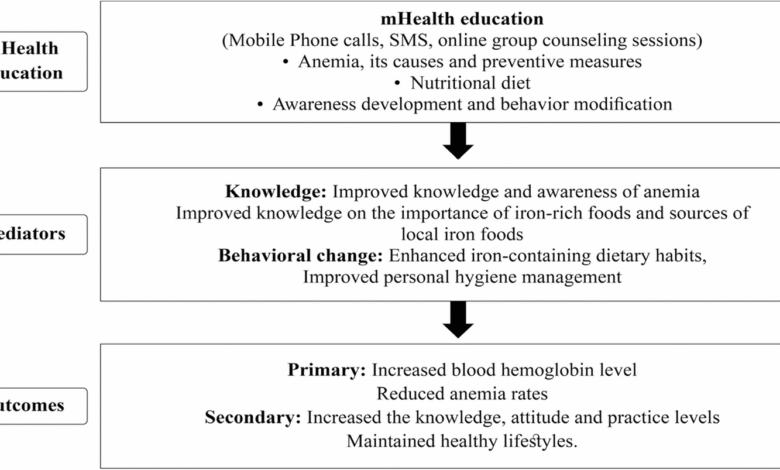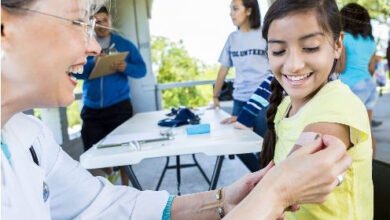Impact of mobile health-based nutritional education on hemoglobin levels in anemic adolescent girls in rural Bangladesh: a randomized controlled trial | BMC Public Health

Information assortment of the members
The neighborhood well being staff (CHWs) collected sociodemographic knowledge, similar to age, household construction, faith, mother and father’ occupation, mother and father’ training, month-to-month household revenue, and KAP info, utilizing field-tested validated survey questionnaires throughout faculty visits. The KAP questionnaire was developed and adopted by the Meals and Agriculture Group of the United Nations [41]. The KAP questionnaire has 22 questions, with 9 specializing in data, 6 on angle, and seven on apply. Subsequently, the CHWs examined anthropometric knowledge on top (cm), weight (kg), mid-upper arm circumference (cm), hip circumference (cm), and waist circumference (cm). To make sure knowledge consistency and decrease self-reported bias educated CHWs carried out knowledge assortment, and two people did the info entry on two separate computer systems. Moreover, blood samples had been collected by an authorized medical laboratory technologist in the course of the faculty visits. An auto hematology analyzer was used to measure hemoglobin ranges, guaranteeing exact and dependable knowledge on anemia standing and its severity. After assessing the eligibility of the examine members, a statistician randomized the faculties for the intervention group and management group; and carried out a easy random sampling to enroll members within the intervention and management teams. Afterward, the analysis personnel in cost opened the participant lists for every faculty, which had been positioned in separate envelopes, to disclose the randomly assigned intervention and management group members after which shared their IDs with the CHWs. Though the CHWs concerned within the trial weren’t blinded to the intervention or management group, they had been blinded to baseline interviews. The CHWs then contacted the trial members within the intervention group, inviting them to take part within the mHealth training program and counseling classes to enhance hemoglobin ranges and thereby scale back anemia.
Along with the baseline evaluation, the CHWs carried out bodily examinations on the finish of the 4th month and eighth month and picked up knowledge in the course of the intervention at their faculty visits. Laboratory technologists collected blood samples throughout these visits. On the finish of the eighth month, the identical KAP questionnaire was used for the evaluation (Desk 1).
KAP evaluation
The KAP questionnaire consisted of twenty-two questions. The data half comprised 9 variables: (1) understanding about anemia, (2) signs of anemia, (3) well being dangers for adolescents owing to an absence of iron within the weight-reduction plan, (4) well being dangers for pregnant ladies lack of iron within the weight-reduction plan, (5) learn about causes of anemia, (6) prevention of anemia (7) know the iron-rich meals, (8) meals that enhance the iron absorption, and (9) drinks that scale back iron absorption. The angle half included six variables: (1) how seemingly assume to be anemic, (2) how critical is anemia, (3) put together meals with iron-rich meals, (4) troublesome to eat or put together meals with iron-rich meals (5) style of iron-rich meals, and (6) confidence in getting ready meals with iron-rich meals. The apply half included seven variables: (1) consumption of iron-rich meals the final week, (2) often consumption of vitamin C/citrus fruits or juice, (3) every single day consuming citrus fruits or juice, (4) timing of consuming citrus fruits, (5), often tea or espresso consumption, (6) on a regular basis drink espresso or tea, and (7) timing of consuming tea or espresso. Every variable was scored as both 0 or 1, with 1 indicating a positive response. In whole, all variables’ scores had been mixed for the imply common.
Questionnaire validity
Following the forward-backward translation process, the English questionnaire was translated into the native language, Bangla. This course of concerned two native Bangla audio system fluent in English: a public well being specialist and a Ph.D. pupil. Every translated the English questionnaire into Bangla independently. Their translations had been then mixed to create a single forward-translated Bangla model. Subsequent, this Bangla model was translated again into English by knowledgeable medical translator, adopted by a second translation by a medical physician not concerned within the earlier steps. The researcher compiled and in contrast these back-translated variations. To make sure validity, all translated variations had been reviewed by an knowledgeable committee. The finalized questionnaire was then pretested with 5% of school-going adolescent women not included in the primary examine. Suggestions from the pretest was collected and integrated into the ultimate model of the questionnaire [31].
Questionnaire reliability
The KAP questionnaire’s reliability was measured by the test-retest technique and Cronbach alpha.
Laboratory investigation
Blood samples had been obtained to measure hemoglobin ranges and white blood cell (WBC) and pink blood cell (RBC) counts. Laboratory exams had been carried out on the Lab Support Diagnostic Heart in Comilla, Bangladesh, utilizing a Sysmex automated hematological analyzer (Mannequin: XN-550). Blood hemoglobin ranges had been measured utilizing a spectrophotometric technique for complete blood samples. High quality management, in accordance with the producer’s pointers, concerned operating management samples with recognized hemoglobin ranges to verify the perfection and accuracy of the analyzer and guarantee dependable outcomes.
Intervention group
On-line group counseling classes and mHealth expertise had been used to supply well being training to the intervention members.
On-line group counseling session: The net group counseling session was designed to advertise behavioral change and create consciousness relating to dietary habits, vitamin, and hygiene administration, all of which may contribute to anemia. The well being training counseling session was carried out for the intervention group by way of Skype for about 90 min. A public well being doctor carried out two classes (baseline and midline) with adolescent women and their guardians. All 69 members and their guardians attended the identical on-line session, which was carried out in a big classroom within the faculty. The session was dwell and interactive. These classes used on-line movies, PowerPoint displays, and discussions to deal with the causes, penalties, prevention, and restoration from anemia. The classes lined subjects similar to iron-rich meals, features and sources of iron, dietary methods, meals habits and plans to enhance iron standing, private hygiene administration, and wholesome life-style practices. On the finish of the session, there was a Query and Reply half, and members requested a number of questions relating to anemia and restoration technique, the general public well being doctor gave detailed solutions and prompt follow-up well being training pointers (Supplementary materials 1). Following the net training classes, the members had been supplied with well being training supplies within the type of notebooks containing info on anemia prevention and an inventory of native iron-containing meals. Modified well being training supplies (notebooks) had been supplied month-to-month to every participant all through the intervention interval (Supplementary supplies 2).
mHealth training: In the course of the 8-month intervention interval, educated feminine CHWs delivered mHealth training by cell phone calls and SMS textual content messaging to boost members’ dietary data, enhance behaviors, dietary habits, and lift consciousness about anemia. Members obtained telephone calls and cellular textual content messages 4 occasions every month within the preliminary 4 months, adopted by thrice in the course of the fifth and sixth months, and eventually twice in the course of the seventh and eighth months. The cellular messages delivered focused well being training on anemia prevention, iron-rich dietary practices, methods to enhance iron absorption, hygiene administration, and wholesome life-style behaviors. Moreover, the CHWs supplied info to the members about domestically obtainable iron-rich meals and their advantages for iron absorption. Additionally they guided avoiding drinks which will hinder iron absorption when consumed with meals, in addition to limiting fatty and oily meals, and emphasised the significance of thorough hand washing earlier than and after consuming. Extra directions included washing fruits rigorously earlier than consumption, carrying sneakers whereas utilizing the bathroom, and completely washing arms after utilizing the bathroom. Members had been additionally suggested on the significance of taking anti-helminth treatment each 6 months and utilizing sanitary napkins throughout menses. Particular person members, together with their guardians, engaged in a 5-minute well being training dialog with CHWs over the telephone. Moreover, they obtained common informative well being training messages that had been up to date weekly (Desk 2).
Management group
The management group obtained normal care and was noticed with none particular intervention all through the trial. Bodily examinations and blood pattern investigations had been carried out on these members on the finish of the 4th and eighth months. The KAP questionnaire interviews had been carried out on the finish of the eighth month. Nonetheless, after every blood check, we supplied onerous copy stories with info on their anemia stage and suggested them to seek the advice of with physicians in the event that they wished. To make sure moral equity, management group obtained all well being training supplies after the intervention interval.
Outcomes
The first end result was improved hemoglobin ranges to scale back anemia in school-going adolescent women.
The secondary outcomes had been as follows:
-
1.
A rise within the scores of KAP associated to anemia, measured utilizing the KAP questionnaire.
-
2.
Enchancment in anthropometric indicators similar to BMI, MUAC, hip circumference, waist circumference.
Final result measures
An automatic analyzer measured blood hemoglobin ranges to evaluate anemia classes (non-anemia, delicate, average, and extreme) in adolescent women. Adolescent women aged 10–11 years with hemoglobin ranges beneath 11.5 g/dL had been categorized as having anemia. Inside this age group, hemoglobin ranges falling inside the ranges of 10–11.4 g/dL, 7.0–9.9 g/dL, and < 7.0 g/dL had been recognized as delicate, average, and extreme anemia, respectively. Equally, nonpregnant adolescent women aged 12–19 years with hemoglobin ranges < 12 g/dL had been thought-about to have any type of anemia. For this older age group, hemoglobin ranges starting from 10.0 to 11.9 g/dL, 7.0–9.9 g/dL, and < 7.0 g/dL had been categorized as delicate, average, and extreme anemia, respectively [11, 17, 39].
After the mHealth training intervention, adjustments in hemoglobin ranges related to anemia had been examined. These adjustments, together with these from anemic to non-anemic, delicate to non-anemic/average/extreme, and average to delicate/non-anemic/extreme, had been assessed at baseline, midline, and endline within the intervention and management group.
The KAP measurement entails a complete of twenty-two variables, together with 9 associated to data, 6 associated to angle, and seven associated to apply. Every variable is scored as 1 for a positive response and 0 for an unfavorable response. Lastly, all variable scores are summed up and analyzed for the imply common.
Statistical evaluation
Initially, the info had been entered into Microsoft Excel 2019 and subsequently imported into the Stata Software program (Model 18.5). Our examine was an RCT, permitting thrice knowledge assortment on the baseline, midline, and endline. Those that supplied incomplete knowledge throughout any time level of knowledge assortment had been thought-about lacking knowledge. After excluding lacking knowledge members (n = 17), a per-protocol evaluation was used to make sure comparability between the management and intervention teams. Descriptive statistics had been analyzed as frequencies, percentages, means, and customary deviations. We carried out a Field Plot evaluation to verify the outlier knowledge, nevertheless it was not detected. Nonetheless, within the baseline evaluation, steady variables between teams had been evaluated utilizing both the impartial t-test or the Mann–Whitney U-test after checking the normality of variables, whereas chi-square exams had been employed to match categorical variables. To judge potential violations of normality assumptions, we carried out the Shapiro–Wilk check to evaluate the info distribution. A p-value > 0.05 indicated usually distributed knowledge, whereas extremely skewed knowledge had been analyzed utilizing non-parametric exams. Blended-effects mannequin was carried out to evaluate varied end result variables, together with hemoglobin ranges and bodily measurements of hip–waist circumference, MUAC, and BMI. Adjustments in KAP scores had been assessed utilizing the Mann–Whitney U check for non-normally distributed knowledge and the impartial t-test for usually distributed knowledge. As well as, we carried out a generalized estimating equations (GEE) mannequin with a Gaussian household and id hyperlink perform to research our examine outcomes. The exchangeable correlation construction was chosen based mostly on the examine design and prior literature. To evaluate the robustness of our findings, we carried out a sensitivity evaluation by refitting the GEE mannequin utilizing totally different correlation constructions (impartial and autoregressive). The GEE mannequin was utilized to estimate the impact of well being training over time after adjusting for age, pupil grade, father’s training and occupation, mom’s training and occupation, and household revenue covariates. Statistical significance was set at p < 0.05 in all analyses.
High quality evaluation
To make sure the standard of the mHealth training in the course of the intervention, we employed a number of key measures. Earlier than the intervention was applied CHWs obtained complete coaching by a public well being doctor and principal investigator relating to the standardized knowledge assortment, well being training supply, and follow-up course of. The principal investigator’s weekly supervision and evaluations of SMS and telephone name content material had been carried out following the examine protocol. CHWs maintained a Microsoft Excel for documenting all of the interactions with the members together with SMS, telephone calls, academic supplies distribution, planning, and suggestions of the members. Moreover, CHWs took help from faculty academics once they encountered issue reaching members. The suggestions was collected month-to-month from members in the course of the in-person supply of well being training notebooks on the faculty, permitting for real-time changes to the intervention. Moreover, sustaining customary procedures throughout on-line counselling classes and telephone interactions confirmed that each one academic content material was delivered as deliberate, thereby guaranteeing prime quality and consistency all through the examine intervention interval.
Digital divide
To reduce the digital divide, this intervention was particularly designed to be delivered by way of telephone calls and SMS, which had been accessible on function telephones and smartphones. This strategy ensures that adolescent women and their households can have interaction with well being training content material with no need web entry or superior expertise.
2025-07-28 11:32:00





